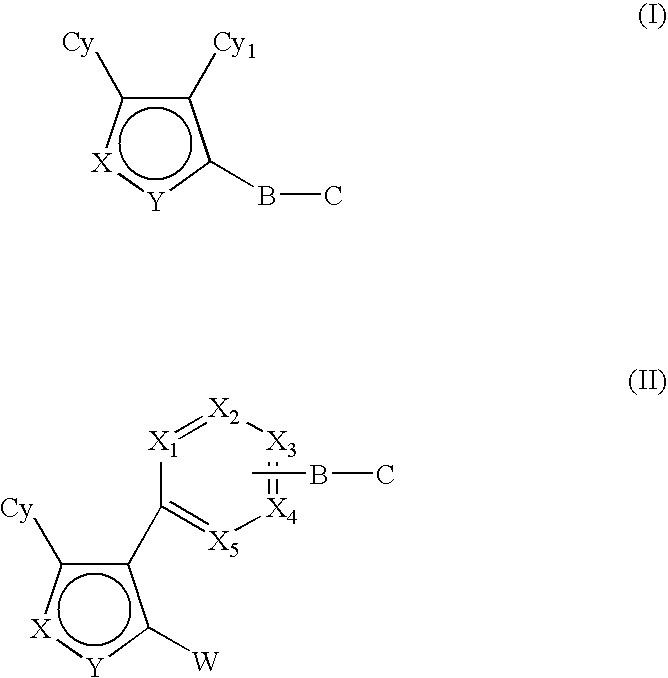Hsp90 inhibitors containing a zinc binding moiety
a technology of hsp90 inhibitors and zinc binding moiety, which is applied in the direction of heterocyclic compound active ingredients, drug compositions, biocide, etc., can solve the problems of limited ability to use such combinations, increased cost and time, and increased regulatory requirements for demonstrating safety and efficacy of combination therapies. , to achieve the effect of enhancing and unexpected properties of inhibitors
- Summary
- Abstract
- Description
- Claims
- Application Information
AI Technical Summary
Benefits of technology
Problems solved by technology
Method used
Image
Examples
example 1
Preparation of 5-(5-chloro-2,4-dihydroxyphenyl)-N-ethyl-4-(4-(4-(hydroxyamino)-4-oxobutoxy)phenyl)isoxazole-3-carboxamide (Compound 1)
Step 1a: (4-Bromophenoxy)(tert-butyl)dimethylsilane (compound 0101)
[0153]Et3N (16.7 g, 115.6 mmol) was added dropwise to a solution of compound 4-bromophenol (10.0 g, 57.8 mmol) and TBSCl (11.3 g, 75.14 mmol) in DMC (100 ml) at room temperature and the mixture was stirred for 2 h. After solvent was removed, 200 ml of petroleum ether was added. The organic layer was wash with water and brine, dried over anhydrous Na2SO4, filtered through a short silica gel column and evaporated to obtain 0101 as a colorless oil (16.6 g, 100%): 1H NMR (CDCl3): δ 0.18 (s, 6H), 2.71 (t, J=6 Hz, 2H), 0.98 (s, 9H), 6.70-6.73 (m, 2H), 7.30-7.33 (m, 2H).
Step 1b: 4-(Tert-butyldimethylsilyloxy)phenylboronic acid (Compound 0102)
[0154]To a solution of compound 0101 (1.548 g, 5.389 mmol) in dry THF (20 ml) was added dropwise a 2.5 M n-BuLi in hexane solution (2.5 ml, 6.326 mmol,) ...
example 2
Preparation of 5-(5-Chloro-2,4-dihydroxyphenyl)-N-ethyl-4-(4-(5-(hydroxyamino)-5-oxopentyloxy)phenyl)isoxazole-3-carboxamide (Compound 2)
Step 2a: Ethyl 5-(4-(5-(2,4-bis(benzyloxy)-5-chlorophenyl)-3-(ethylcarbamoyl)isoxazol-4-yl)phenoxy)pentanoate (Compound 0110-2)
[0166]The title compound 0110-2 was prepared (320 mg, 52%) from 0109 (500 mg, 0.90 mmol) and ethyl 5-bromopentanoate (226 mg, 1.08 mmol) using a procedure similar to that described for compound 0110-1 (Example 1): LCMS: 683 [M+1]+.
Step 2b: Ethyl 5-(4-(5-(5-chloro-2,4-dihydroxyphenyl)-3-(ethyl-carbamoyl)isoxazol-4-yl)phenoxy)pentanoate (Compound 0111-2)
[0167]The title compound 0111-2 was prepared (81 mg, 37%) from 0110-2 (296 mg, 0.44 mmol) using a procedure similar to that described for compound 0110-1 (Example 1): LCMS: 503 [M+1]+.
Step 2c: 5-(5-Chloro-2,4-dihydroxyphenyl)-N-ethyl-4-(4-(5-(hydroxyamino)-5-oxopentyloxy)phenyl)isoxazole-3-carboxamide (Compound 2)
[0168]The title compound 2 was prepared (50 mg, 64%) from compou...
example 3
Preparation of 5-(5-Chloro-2,4-dihydroxyphenyl)-N-ethyl-4-(4-(6-(hydroxyamino)-6-oxohexyloxy)phenyl)isoxazole-3-carboxamide (Compound 3)
Step 3a: Ethyl 6-(4-(5-(2,4-bis(benzyloxy)-5-chlorophenyl)-3-(ethylcarbamoyl)isoxazol-4-yl)phenoxy)hexanoate (Compound 0110-3)
[0169]The title compound 0110-3 was prepared (800 mg, 66%) from 0109 (1.00 g, 1.80 mmol) and ethyl 6-bromohexanoate (0.44 g, 1.97 mmol) using a procedure similar to that described for compound 0110-1 (Example 1): LCMS: 697 [M+1]+.
Step 3b: Ethyl 6-(4-(5-(5-chloro-2,4-dihydroxyphenyl)-3-(ethyl-carbamoyl)isoxazol-4-yl)phenoxy)hexanoate (0111-3)
[0170]The title compound 0111-3 was prepared (300 mg, 58%) from 0110-3 (700 mg, 1.0 mmol) using a procedure similar to that described for compound 0110-1 (Example 1): LCMS: 517 [M+1]+.
Step 3c: 5-(5-Chloro-2,4-dihydroxyphenyl)-N-ethyl-4-(4-(6-(hydroxyamino)-6-oxohexyloxy)phenyl)isoxazole-3-carboxamide (Compound 3)
[0171]The title compound 3 was prepared (80 mg, 32%) from compound 0111-3 (260...
PUM
| Property | Measurement | Unit |
|---|---|---|
| body weight | aaaaa | aaaaa |
| body weight | aaaaa | aaaaa |
| temperature | aaaaa | aaaaa |
Abstract
Description
Claims
Application Information
 Login to View More
Login to View More - R&D
- Intellectual Property
- Life Sciences
- Materials
- Tech Scout
- Unparalleled Data Quality
- Higher Quality Content
- 60% Fewer Hallucinations
Browse by: Latest US Patents, China's latest patents, Technical Efficacy Thesaurus, Application Domain, Technology Topic, Popular Technical Reports.
© 2025 PatSnap. All rights reserved.Legal|Privacy policy|Modern Slavery Act Transparency Statement|Sitemap|About US| Contact US: help@patsnap.com



